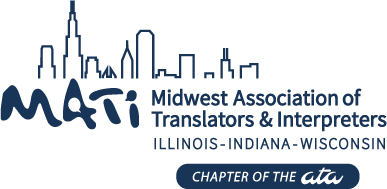Cris Silva on “Educating the Next Generation of
Translators and Interpreters”
By Katalin Young
At MATI’s 12th Annual Conference, held in Merrillville, Indiana on September 26, Cris Silva discussed different methods for teaching translation and interpreting in the presentation, “Online Education for the Next Generation of Translators and Interpreters.” During her presentation, Silva explored concerns and issues associated with the teaching of such fields online, a format with its own challenges and advantages.
Silva first briefly presented the worldwide history of T&I (translation & interpreting) education, which has its roots in the Université de Genève, Switzerland, one of the oldest T&I schools in the world. Through the technological developments of the ages, we have now progressed to our current ability to carry out education in an online format. Moreover, thanks to the advantages posed by globalization and virtual connectivity, we have access to countless resources that can be used in the teaching of T&I, including Skype, FB and online forums, just to name a few. This is the context in which distance learning now takes place, an educational “environment” in which teachers and students are in different physical locations while participating in the same educational events. The concept of distance education is actually not new though, according to Silva, beginning as early as the 1700’s. E-learning, on the other hand, began around the 1960’s in Stanford, where they used computers in elementary schools for teaching both math and reading.
Silva next highlighted the two possible modes of e-learning: synchronous and asynchronous learning. Synchronous learning, she noted, is most often associated with the traditional classroom setting: students learning together in the same place at the same time from a lecture or lesson being presented by an instructor. However, Silva pointed out that e learning can also take place within a synchronous format. For example, webinars bring trainers and students together and have the added bonus of being recordable to be consumed later. Alternatively, asynchronous learning does not require all parties to be in the same location at the same time; for example, for online classes, the instructor can post something on the web for students to view later at a time convenient for them.
As you might imagine, there are advantages and disadvantages for both modes and settings, and for online classes versus face-to-face instruction as well. However, Silva emphasized the biggest concern for the online environment, saying, “Bandwidth is everything.” Although online instruction involves several technical requirements for both students and instructors, Silva noted that this was the most important requirement to keep in mind. Beyond the challenges associated with technology, Silva noted that teaching students’ with multiple individual language pairs is much more challenging for instructors than teaching to a single language pair. In addition, the format of classes needs to be considered. According to Silva, the most typical format consists of core classes, electives or specialty classes, and a capstone project at the end of the program. Courses may include activities that Silva carries out in her own classes, like screen sharing, the use and discussion of translators’ logs, and peer-editing.
Overall, Silva framed the above discussion around the teachability of the fields of translation and interpreting (T&I) as a whole. She posed questions to the audience, like are these tasks skills? If so, then, can they be taught to others? Audience members seemed to agree that T&I are skills, and the next question considered was how one then teaches the art of translation and interpreting, and if that art can even be taught? Further questions considered included what the minimum curriculum for teaching the skill and/or art of T&I should look like? And for those with a natural talent, is training even necessary? Audience members seemed to reach the consensus that although T&I requires at least a bit of natural talent, training is also necessary. On the flip side, for teachers of the art and skill of T&I, Silva aligned herself with Max Troyer, who once said, “We’re not teachers of translation and interpretation, just translators and interpreters who like to teach.”
Cris Silva graduated from Kent State University, where she obtained an MA in translation. She currently lives in Colorado, where she has continued her work as a project and terminology manager, freelance translator, conference interpreter, and voice-over talent. She also teaches translation at institutions such as the Middlebury Institute of International Studies at Monterey’s Graduate School of Translation, Interpretation, and Language Education, New York University, and the University of Denver. Before becoming a full-time linguist and project manager, she worked in radio broadcasting. She is also an ATA-certified English>Portuguese translator.
Katalin Young is an MA student at the University of Illinois in Urbana-Champaign and is focusing on Conference and Community Interpreting in the Translation Studies program. Although she is dedicated to the practice of Spanish<>English interpreting, she has also studied many other languages, including Mandarin Chinese, American Sign Language, Catalan, and currently, Korean.
